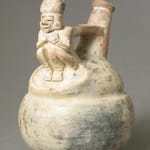La Tolita Terracotta Vessel Featuring a Squatting Figure, 400 BCE - 400 CE
Terracotta
5.5
PF.2774
Further images
-
(View a larger image of thumbnail 1
)

-
(View a larger image of thumbnail 2
)

-
(View a larger image of thumbnail 3
)

-
(View a larger image of thumbnail 4
)

-
(View a larger image of thumbnail 5
)

-
(View a larger image of thumbnail 6
)

-
(View a larger image of thumbnail 7
)

-
(View a larger image of thumbnail 8
)

The Pre-Columbian cultures of Ecuador are among the oldest in South America and among the first to master the art of pottery. Although we know little about the peoples themselves...
The Pre-Columbian cultures of Ecuador are among the oldest in South America and among the first to master the art of pottery. Although we know little about the peoples themselves or their traditions, historians have been able to piece together a picture of life in Ancient Ecuador thanks in part to the art and artifacts left behind. The culture of Valdivia created some of the oldest known works of art in the Americas. Situated along the coastal strip of Ecuador, the Valdivians established a thriving society that flourished for around two thousand years (from approximately 3500 to 1500 B.C.). Today they are famed for their small fertility figures, believed to be the earliest representational works of art in the Americas, first carved from stone, later formed from terracotta.
Hundreds of years later after the Valdivians disappear from the archaeological record appears another culture to which the name Chorrera has been attached (lasting from circa 1100-300 B.C.). Little is known about this culture; however, it is significant for its widespread geographical reach. As such, their artistic style greatly influenced those diverse cultures that began to emerge in the final centuries of the Chorrera period, a time historians have labeled the Period of Regional Development.
Among the most prominent cultures that flourished in the wake of the Chorrera are the cultures of Bahia, Jama Coaque, and La Tolita. Around 400 B.C. the culture of La Tolita emerged, centered on the island of La Tolita, from which its name derived, lasting until roughly 400 A.D. The island was a great ceremonial center to which flocked worshippers from varying regions of Pre-Columbian Ecuador to pray to their gods and bury their deceased. As a result, a sophisticated artistic tradition developed in order to provide pilgrims with sculptural offerings, luxurious festive attire and funerary apparels.
This lovely vessel is all the more valuable because of its rarity. The piece has maintained an overall beige shade. The charming figure nestled on top of the vessel resembles a shaman with a pose of a man with many secrets of the ancient world to keep.
Hundreds of years later after the Valdivians disappear from the archaeological record appears another culture to which the name Chorrera has been attached (lasting from circa 1100-300 B.C.). Little is known about this culture; however, it is significant for its widespread geographical reach. As such, their artistic style greatly influenced those diverse cultures that began to emerge in the final centuries of the Chorrera period, a time historians have labeled the Period of Regional Development.
Among the most prominent cultures that flourished in the wake of the Chorrera are the cultures of Bahia, Jama Coaque, and La Tolita. Around 400 B.C. the culture of La Tolita emerged, centered on the island of La Tolita, from which its name derived, lasting until roughly 400 A.D. The island was a great ceremonial center to which flocked worshippers from varying regions of Pre-Columbian Ecuador to pray to their gods and bury their deceased. As a result, a sophisticated artistic tradition developed in order to provide pilgrims with sculptural offerings, luxurious festive attire and funerary apparels.
This lovely vessel is all the more valuable because of its rarity. The piece has maintained an overall beige shade. The charming figure nestled on top of the vessel resembles a shaman with a pose of a man with many secrets of the ancient world to keep.







